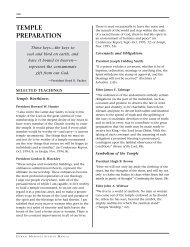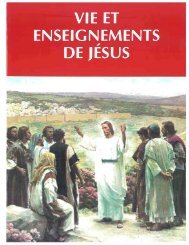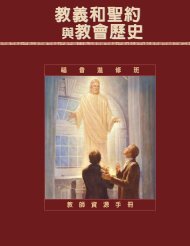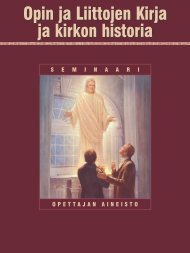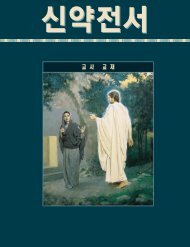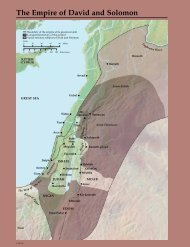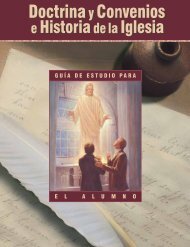Daniel
Daniel
Daniel
- No tags were found...
Create successful ePaper yourself
Turn your PDF publications into a flip-book with our unique Google optimized e-Paper software.
the Caesars was the legs of iron. For mark you, lateron the kingdom, or empire of Rome, was divided. Thehead of the government in one division was at Rome andthe head of the government in the other division wasat Constantinople. So these two great divisionsrepresented the legs of iron. Finally, the Roman empirewas broken up into smaller kingdoms, represented bythe feet and toes of iron and clay.” (In ConferenceReport, Apr. 1930, p. 32).Elder Orson Pratt, in explaining why the toes wereshown as being partly iron and partly clay, said that“the feet and toes were governments more modern togrow out of the iron kingdom [Roman Empire], after itshould lose its strength. These are represented by theten toes or ten kingdoms which should be partly strongand partly broken. They should not have the strengthof the legs of iron, but they should be mixed with miryclay, indicating both strength and weakness.” (In Journalof Discourses, 18:337.)President Spencer W. Kimball further clarified theprophecy with the following explanation:“Rome would be replaced by a group of nations ofEurope represented by the toes of the image.“With the history of the world delineated in brief,now came the real revelation. <strong>Daniel</strong> said:“‘And in the days of these kings [that is, the groupof European nations] shall the God of heaven set upa kingdom, which shall never be destroyed . . .“This is a revelation concerning the history of theworld, when one world power would supersede anotheruntil there would be numerous smaller kingdoms toshare the control of the earth.“And it was in the days of these kings that powerwould not be given to men, but the God of heavenwould set up a kingdom—the kingdom of God uponthe earth, which should never be destroyed nor left toother people.“The Church of Jesus Christ of Latter-day Saints wasrestored in 1830 after numerous revelations from thedivine source; and this is the kingdom, set up by theGod of heaven, that would never be destroyed norsuperseded, and the stone cut out of the mountainwithout hands that would become a great mountainand would fill the whole earth.” (In Conference Report,Apr. 1976, p. 10.)(28-14) <strong>Daniel</strong> 2:44–45. How Is It That the KingdomSet Up by God Will Consume the Other Kingdoms?Section 65 of the Doctrine and Covenants tells of thefulfillment of the rest of <strong>Daniel</strong>’s prophecy. The ProphetJoseph Smith prayed that the ecclesiastical kingdomof God, which was established on the earth in his day,might roll forth that the future kingdom of heavenmight come.“During the millennium the kingdom of God willcontinue on earth, but in that day it will be bothan ecclesiastical and a political kingdom. That is, theChurch (which is the kingdom) will have the ruleand government of the world given to it.” (Bruce R.McConkie, Mormon Doctrine, p. 416.)That millennial kingdom can also be properly referredto as the kingdom of heaven, as Joseph Smith did in hisinspired prayer recorded in Doctrine and Covenants 65.The establishment of that kingdom is what the Lordtaught the Saints to pray for in the Lord’s Prayer whenHe said, “Thy kingdom come” (Matthew 6:10; see alsoJoseph Fielding Smith, Doctrines of Salvation, 1:230).The coming forth of the kingdom on the earth is what<strong>Daniel</strong> saw when the stone rolled forth and smote theimage, eventually filling the whole earth.President Brigham Young taught: “The Lord GodAlmighty has set up a kingdom that will sway thesceptre of power and authority over all the kingdomsof the world, and will never be destroyed, it is thekingdom that <strong>Daniel</strong> saw and wrote of. It may beconsidered treason to say that the kingdom which thatProphet foretold is actually set up; that we cannot help,but we know it is so, and call upon the nations tobelieve our testimony. The kingdom will continue toincrease, to grow, to spread and prosper more andmore. Every time its enemies undertake to overthrowit, it will become more extensive and powerful; insteadof its decreasing, it will continue to increase, it willspread the more, become more wonderful andconspicuous to the nations, until it fills the wholeearth.” (In Journal of Discourses, 1:202–3.)(28-15) <strong>Daniel</strong> 2:49. <strong>Daniel</strong> Prospered Because of HisRighteousnessPresident Spencer W. Kimball summarized thequalities that <strong>Daniel</strong> possessed and the blessingshis obedience to God brought him: “The gospel was<strong>Daniel</strong>’s life. . . . In the king’s court, he could be littlecriticized, but even for a ruler he would not drink theking’s wine nor gorge himself with meat and richfoods. His moderation and his purity of faith broughthim health and wisdom and knowledge and skill andunderstanding, and his faith linked him closely to hisFather in heaven, and revelations came to him as oftenas required. His revealing of the dreams of the kingand the interpretations thereof brought him honorand acclaim and gifts and high position such as manymen would sell their souls to get.” (In ConferenceReport, Mexico and Central America Area Conference1972, p. 31.)(28-16) <strong>Daniel</strong> 3:1–18. Three Hebrews Who Were Trueto God in Spite of Threats and Pressure<strong>Daniel</strong> did not stand alone as an exemplary youngman. His three companions demonstrated the sameunswerving loyalty and devotion to God. Of them ElderSpencer W. Kimball said: “We remind ourselves of theintegrity of the three Hebrews, Shadrach, Meshach,and Abednego, who like <strong>Daniel</strong> defied men and rulers,to be true to themselves and to keep faith with theirfaith. They were required by decree of the emperor tokneel down and worship a monumental image of goldwhich the king had set up. In the face of losing caste,of losing position, of angering the king, they faced thefiery furnace rather than to fail and deny their God.The cunningly devised scheme worked as the viciousplanners expected. The dedication must have beenexciting with the people from far and near attending.Had there ever been such an image? such a spectacle?Ninety feet of gold in the form of a man—what couldbe more scintillating, more sparkling? There must havebeen almost countless people milling in the streets andin the area where the gigantic image stood when theherald announced the procedure and the decree thatall must kneel at the sound of the music and all mustworship the image. Neither the cunning of the deceivers,the conspiring, cunning tricksters, nor the fear of the299
king and what he could do to them, dissuaded thethree courageous young men from their true path ofrightness. When the prearranged sounds of the cornet,flute, harp and other instruments reverberated throughthe area and the masses of men and womeneverywhere filled their homes and the streets withkneeling worshippers of the huge golden image, threemen refused to insult their true God. They prayed toGod, and when confronted by the raging and furiousemperor king, they courageously answered in the faceof what could be certain death: [<strong>Daniel</strong> 3:17–18.]”(Integrity, Brigham Young University Speeches of theYear [25 Feb. 1964], p. 18.)(28-17) <strong>Daniel</strong> 3:19–23. The Casting of Shadrach,Meshach, and Abed-nego into the FurnaceTo heat the furnace “seven times more than it waswont to be” (<strong>Daniel</strong> 3:19) is presumed to be an idiomaticway of saying that the furnace was to be heated muchhotter than usual—to be heated as hot as it could beheated (see Clarke, Commentary, 4:578). “If the threewere brought up to the furnace, it must have had amouth above, through which the victims could be castinto it. When heated to an ordinary degree, this couldbe done without danger to the men who performedthis service; but in the present case the heat of the firewas so great, that the servants themselves perished byit.” (C. F. Keil and F. Delitzsch, Commentary on the OldTestament, 9:3:130.)The king apparently viewed the events in the furnacethrough an opening at the bottom (see D. Guthrie andJ. A. Motyer, eds., The New Bible Commentary: Revised,p. 692).(28-18) <strong>Daniel</strong> 4:8–9. “The Spirit of the Holy Gods”That Nebuchadnezzar recognized <strong>Daniel</strong>’sability to receive revelation from God is clear fromthe events associated with <strong>Daniel</strong>’s interpretation ofNebuchadnezzar’s previous dream (see <strong>Daniel</strong> 2:46–47).The heathens believed that “the revelation ofsupernatural secrets belonged to the gods, and that theman who had this power must possess the spirit of thegods” (Keil and Delitzsch, Commentary, 9:3:147).<strong>Daniel</strong>’s spiritual powers, however, did not necessarilyconvert Nebuchadnezzar from his polytheistic beliefsor his belief in the supreme Babylonian god Bel.By acknowledging <strong>Daniel</strong>’s spiritual abilities,Nebuchadnezzar was not acknowledging Jehovahas the only or even the supreme god.(28-19) <strong>Daniel</strong> 4:19. Why Was <strong>Daniel</strong> “Astonied”?The word astonied is an archaic word that means“bewildered” or “filled with consternation or dismay.”<strong>Daniel</strong> was troubled because he knew that the messageof Nebuchadnezzar’s dream was not good. He knewhe must announce to Nebuchadnezzar the judgmentsof God to come upon him. Nebuchadnezzar noticed<strong>Daniel</strong>’s concern and realized that <strong>Daniel</strong> had theinterpretation. “He asks him, with friendly address, totell him it without reserve. <strong>Daniel</strong> then communicatesit in words of affectionate interest for the welfare ofthe king. The words, let the dream be to thine enemies,etc., do not mean: it is a dream, a prophecy, such as theenemies of the king might ungraciously wish (Klief.), but:may the dream with its interpretation be to thine enemies,may it be fulfilled to them or refer to them.” (Keil andDelitzsch, Commentary, 9:3:154.)© Quebecor World Inc.Shadrach, Meshach, and Abed-nego were placed in a fiery furnace.(28-20) <strong>Daniel</strong> 4:27. “A Lengthening of Thy Tranquility”<strong>Daniel</strong> counseled the king to reform his life, torepent of his sins, and to show greater mercy to thepoor. The implication of <strong>Daniel</strong>’s statement is that ifNebuchadnezzar would do as he was counseled, hemight receive divine favor and avert the threatenedpunishment, thus maintaining his prosperity of life.Mercy to the poor was mentioned as a prerequisiteto obtaining forgiveness of sin. It is one of the mostsincere evidences of repentance and submission to theLord’s will. (Compare James 1:27.)(28-21) <strong>Daniel</strong> 4:34–37. Nebuchadnezzar’s Praiseof GodThat Nebuchadnezzar praised and glorified Godafter his reason was restored to him indicates that herecognized his experience as a just punishment for hispride. It does not necessarily follow, however, that thisexperience caused his sincere repentance or conversionto the God of <strong>Daniel</strong>. Nevertheless, it is remarkablethat <strong>Daniel</strong> had even that much influence on a mansteeped in idolatry and heathen superstitions.(28-22) <strong>Daniel</strong> 5:1. Belshazzar the KingMany scholars have questioned the validity of thestatement that Belshazzar was a king in Babylon because“Belshazzar never reigned as sole king, and is neverdesignated as king (sharru) in the cuneiform inscriptions.Furthermore, it is maintained that there is no evidenceto show that Belshazzar ever ruled upon the throne as300
Vessels of the temple: altar of incense, golden candlestick, table of shewbread, and ark of the covenanta subordinate to Nabonidus his father. In reply to thesecharges we may note, first of all, that the Aramaic wordmalka (‘king’) need not have the connotation of monarchor sole king (see R. D. Wilson, Studies in the Bookof <strong>Daniel</strong>, 1917, pp. 83–95). Furthermore, one of thecuneiform documents expressly states that Nabonidusentrusted the kingship to Belshazzar. . . . In allprobability there was a coregency between Nabonidusand Belshazzar in which Belshazzar occupied asubordinate position. Since, however, he was the manupon the throne with whom Israel had to do, he isdesignated king in the book of <strong>Daniel</strong>. No valid objectioncan be raised against this usage.” (Guthrie and Motyer,New Bible Commentary, p. 694.)(28-23) <strong>Daniel</strong> 5:3. Drinking from the Vessels of theTempleWhen the Babylonians overthrew Jerusalem, they“carried out thence all the treasures of the house of theLord” (2 Kings 24:13). As Keil and Delitzsch noted,during the feast the Babylonians “drank out of the holyvessels of the temple of the God of Israel to glorify . . .their heathen gods in songs of praise. In doing this theydid not only place ‘Jehovah on a perfect level with theirgods’ (Havernick), but raised them above the Lord ofheaven, as <strong>Daniel</strong> (ver. 23) charged the king. The carryingaway of the temple vessels to Babylon and placing themin the temple of Bel was a sign of the defeat of the Godto whom these vessels were consecrated; . . . the use ofthese vessels in the drinking of wine at a festival, amidthe singing of songs in praise of the gods, wasaccordingly a celebrating of these gods as victoriousover the God of Israel.” (Commentary, 9:3:180.)(28-24) <strong>Daniel</strong> 5:6. What Is Meant by the Phrase the“Joints of His Loins Were Loosed”?The great fear that came upon the king is describedin the Revised Standard Version of the Bible as: “Hislimbs gave way, and his knees knocked together”(<strong>Daniel</strong> 5:6).(28-25) <strong>Daniel</strong> 5:7. The Third Ruler in the KingdomThe Hebrew word that is translated “third ruler”means “one of three” (Guthrie and Motyer, New BibleCommentary, p. 694). The promise was that the interpreterof the writing would be made third in authority in thekingdom next to Nabonidus and Belshazzar. The scarlet(sometimes purple) clothing and the chain of goldmentioned in <strong>Daniel</strong> 5:7 were symbols of rank wornby high officials.(28-26) <strong>Daniel</strong> 5:17. “Let Thy Gifts Be to Thyself”Those who function under the influence of the Spiritof God have increased capabilities, not because of theirown qualifications, but because of the power of Godwhich they are privileged to use. They are servants inthe Lord’s hands who are to bless others and carry out301
the Lord’s will. <strong>Daniel</strong> knew this and neither deservednor sought for earthly rewards for his role as aninstrument in the hands of God.(28-27) <strong>Daniel</strong> 5:25–29. The Interpretation of theHandwriting on the WallThe handwriting on the wall indicated not only thatthe Babylonian kingdom would be overthrown but alsothe means by which it would be overthrown: “MENE,‘numbered’, i.e. God has numbered . . . the days of thekingdom; TEKEL, a ‘shekel’, used both as a coin andas a weight, indicated that Belshazzar was weighed (inthe balances) and found deficient; PERES, ‘division’,your kingdom is divided (peres) and given to the Medesand Persians (paras). The word paras would seem topoint out that the Persians were the dominant powerto whom Babylon would fall. When <strong>Daniel</strong> read thewriting he read and PARSIN (v. 25), but in giving theinterpretation he employed the form PERES (v. 28). . . .We have thus a play upon words in which the basicidea of division is linked with the name of theconqueror.” (Guthrie and Motyer, New BibleCommentary, p. 694.)(28-28) <strong>Daniel</strong> 5:29. Why Was <strong>Daniel</strong> Rewarded by theKing When He Prophesied of the King’s Destruction?Although Belshazzar did not believe that <strong>Daniel</strong>’sGod was the only true God, it is likely that he, likeother heathens, believed in the gods and in revelationsfrom God. He must have been deeply impressed with<strong>Daniel</strong>’s ability to interpret the writing on the wallbecause he rewarded him handsomely. Keil andDelitzsch suggested another possible reason:“Belshazzar perhaps scarcely believed the threatenedjudgment from God to be so near as it actually was . . .and perhaps . . . he hoped to be able, by conferringhonour upon <strong>Daniel</strong>, to appease the wrath of God”(Keil and Delitzsch, Commentary, 9:3:191).(28-29) <strong>Daniel</strong> 5:30. Was Babylon Really Overthrownin One Night?Babylon was surrounded by a massive wall over onehundred feet thick and three hundred feet high (seeEnrichment G). To breach such a wall, even with constantsieging, would take months, and yet there is no hintin <strong>Daniel</strong>’s record that the city was under siege at thistime. Could a city of Babylon’s size and fortificationsbe taken in one night?Historical sources other than the Bible indicate thatthat is exactly what happened, supporting <strong>Daniel</strong>’srecord exactly. The ancient Greek historian, Herodotus,recorded that “Cyrus had previously caused thePallacopas, a canal which ran west of the city, and carriedoff the superfluous water of the Euphrates into the lakeof Nitocris, to be cleared out, in order to turn the riverinto it; which, by this means, was rendered so shallowCyrus diverted the water and marched his soldiers under the wall of Babylon.302
that his soldiers were able to penetrate along its bedinto the city.” (In Samuel Fallows, ed., The Popular andCritical Bible Encyclopedia and Scriptural Dictionary,s.v. “Babylon,” p. 207.)Thus the Persians marched under the massive walls.Harry Thomas Frank discussed the reasons why thecity, even then, surrendered so easily: “Cyrus’ orderspreceded him to the city. No revenge was to be taken.The city was to have its normal life restored as quicklyas possible. The gods which Nabonidus had takenfrom the equally well-treated provincial cities wereto be restored at once. There was, above all, to be noterrorizing of the population. Indeed, Cyrus intendedto change some of the policies of Nabonidus whichhad made him objectionable to his subjects. One canimagine the reception Cyrus received when he madehis appearance in the capital a few weeks after itscapture. He was not a conqueror. He was a liberator!And far from installing a foreign rule over the people,Cyrus personally took the role of Marduk, the chiefgod of Babylon, in the New Year Festival, therebyclaiming for himself and his heirs the right to rulethe Babylonian Empire by divine designation.”(Discovering the Biblical World, p. 140.)The Great SeaAshdodCanaan under Persian ruleDorIdumea(Edomites)GalileeSamariaJudahKarnaimGileadAmmonMoabHauran(28-30) <strong>Daniel</strong> 6:1–3. Did the Medes and PersiansRecognize the Promotion Given to <strong>Daniel</strong> byBelshazzar in the Last Hours of His Reign?Keil and Delitzsch commented on this issue: “Thesuccessor [to Belshazzar] would be inclined toward itsrecognition [<strong>Daniel</strong>’s promotion] by the reflection, thatby <strong>Daniel</strong>’s interpretation of the mysterious writingfrom God the putting of Belshazzar to death appearedto have a higher sanction, presenting itself as if it weresomething determined in the councils of the gods,whereby the successor might claim before the peoplethat his usurpation of the throne was renderedlegitimate. Such a reflection might move him to confirm<strong>Daniel</strong>’s elevation to the office to which Belshazzarhad raised him.” (Commentary, 9:3:190–91.)Though the above may be true, <strong>Daniel</strong>’s great capacityshould not be discounted. A wise ruler would recognizeand use a man of <strong>Daniel</strong>’s stature.(28-31) <strong>Daniel</strong> 6:10. <strong>Daniel</strong>’s Response to a HeathenDecreeThose who are righteous do not fear other people.Their only desire is to serve and honor God. With thesame faith that his brethren Shadrach, Meshach, andAbed-nego had shown in refusing to bow down to theidol, <strong>Daniel</strong> refused to follow the decree that condemnedpetitions to any god but the king. “This unalterablelaw of the Medes and Persians would have beenterrifying to any man, but the faithful <strong>Daniel</strong> did notflinch. Was there any question what he should do? Hecould save his life by abandoning his prayers to theLiving God. What was he to do? A man of integritycould not fail. <strong>Daniel</strong> was the soul of integrity.”(Kimball, Integrity, p. 17.)(28-32) <strong>Daniel</strong> 6:10. Why Did <strong>Daniel</strong> Pray ThreeTimes a Day toward Jerusalem?Solomon, in his dedicatory prayer of the temple inJerusalem, referred to the people’s praying “towardthe city which thou hast chosen, and toward the housethat I have built for thy name” (1 Kings 8:44). TheProphet Joseph Smith once counseled the TwelveApostles to “make yourselves acquainted with thosemen who like <strong>Daniel</strong> pray three times a day towardthe House of the Lord” (History of the Church, 3:391).And President Wilford Woodruff, in the dedicatoryprayer on the Salt Lake Temple, said: “Heavenly Father,when thy people shall not have the opportunity ofentering this holy house to offer their supplicationsunto thee, and they are oppressed and in trouble,surrounded by difficulties or assailed by temptation,and shall turn their faces towards this thy holy house andask thee for deliverance, for help, for thy power tobe extended in their behalf, we beseech thee to lookdown from thy holy habitation in mercy and tendercompassion upon them, and listen to their cries.”(In James E. Talmage, The House of the Lord, p. 142;emphasis added.)This is not to suggest that the direction in which onefaces when one prays has mystical significance, but,rather, that it is an attitude of spiritual “facing.” To facethe temple, which is the temporal representation of theHouse of God, suggests that one turns one’s heart tothe Lord and the covenants made in the temples to bemore like Him. President Woodruff clarified this pointin what he said next: “Or when the children of thypeople, in years to come, shall be separated, throughany cause, from this place, and their hearts shall turn inremembrance of thy promises to this holy Temple, and theyshall cry unto thee from the depths of their afflictionand sorrow to extend relief and deliverance to them,303
we humbly entreat thee to turn thine ear in mercy tothem; hearken to their cries, and grant unto them theblessings for which they ask.” (In Talmage, House of theLord, p. 142; emphasis added.)(28-33) <strong>Daniel</strong> 6:24. <strong>Daniel</strong>’s Accusers Cast into theLions’ DenThe term or ever, as used in <strong>Daniel</strong> 6:24, means“before.” Some have attacked the cruelty of condemningthe women and children, too. To an absolute monarch,however, it probably seemed the logical thing to do,for out of these families might come insurrection in thefuture. The lesson must be severe enough to warn anyothers who might be jealous of the king’s favorite andmost valuable servant. An absolute monarch wouldlikely feel that any other course would slowly causehim to lose power.(28-34) <strong>Daniel</strong> 6:28. <strong>Daniel</strong> Prospered“He had served five kings: Nebuchadnezzar,Evil-merodach, Belshazzar, Darius, and Cyrus. Few courtiershave had so long a reign, served so many masterswithout flattering any, been more successful in theirmanagement of public affairs, been so useful to thestates where they were in office, or have been moreowned of God, or have left such an example toposterity.” (Clarke, Commentary, 4:590.)(28-35) <strong>Daniel</strong> 7:1–28. What Was Represented by theBeasts <strong>Daniel</strong> Saw?Like chapter 2, chapter 7 gives a pictorialrepresentation of history: There are four successiveempires, and then the kingdom of God is established.Chapter 7, however, seems to relate more to theestablishment of the ecclesiastical aspects of thekingdom, whereas chapter 2 deals more with thepolitical aspects of the kingdom of God.The Prophet Joseph Smith taught the followingabout <strong>Daniel</strong>’s vision of the beasts:“You there see that the beasts are spoken of torepresent the kingdoms of the world, the inhabitantswhereof were beastly and abominable characters; theywere murderers, corrupt, carnivorous, and brutal intheir dispositions. The lion, the bear, the leopard, andthe ten-horned beast represented the kingdoms of theworld, says <strong>Daniel</strong>. ...“. . . The prophets do not declare that they saw abeast or beasts, but that they saw the image or figure ofa beast. <strong>Daniel</strong> did not see an actual bear or a lion, butthe images or figures of those beasts. The translationshould have been rendered ‘image’ instead of ‘beast,’in every instance where beasts are mentioned by theprophets. . . . When the prophets speak of seeing beastsin their visions, they mean that they saw the images,they being types to represent certain things. At thesame time they received the interpretation as to whatthose images or types were designed to represent.”(Teachings of the Prophet Joseph Smith, pp. 289, 291.)(28-36) <strong>Daniel</strong> 7:2–8. Must One Understand All theProphetic Imagery Given in the Scriptures?See the statement by the Prophet Joseph Smithquoted in Notes and Commentary on Ezekiel1:15–21.(28-37) <strong>Daniel</strong> 7:4–8. What Is the Connection betweenthe Four Beasts and Historical Events?As mentioned in <strong>Daniel</strong> 7:17, the four beastsrepresented “four kings [or kingdoms] which shallarise out of the earth.” The first, which was like a lionwith eagles’ wings, represented the Babylonian kingdomunder Nebuchadnezzar. The lion and eagle are bothsupreme among beasts of their class. The head of goldin the dream of chapter 2 can be similarly compared.“What the gold is among metals and the head amongthe members of the body, that the lion is amongbeasts and the eagle among birds” (Keil and Delitzsch,Commentary, 9:3:223). The plucking of feathers (see<strong>Daniel</strong> 7:4) seems to have represented a deprivationof power to fly or the power to dominate and conquer.The change that gave it a man’s heart is evidently areference to the humanizing effect of Nebuchadnezzar’smadness (see <strong>Daniel</strong> 4:34–37).The second beast (see <strong>Daniel</strong> 7:2) represented theMedian-Persian Empire, as did the breast and arms ofsilver in the image of chapter 2. The bear was considerednext to the lion as the strongest among animals by thepeople of the ancient Middle East. The raising up onone side could represent the raising of the forefeet ofthe bear (standing on its hind feet) as when it goes afterprey. “The Medo-Persian bear, as such, has . . . two sides:the one, the Median side, is at rest after the efforts madefor the erection of the world-kingdom; but the other,the Persian side, raises itself up, and then becomes notonly higher than the first, but also is prepared for newrapine.” (Keil and Delitzsch, Commentary, 9:3:225.) Theribs held between the bear’s teeth and its devouring“much flesh” (<strong>Daniel</strong> 7:5) signify the ferocity withwhich its dominion would be exerted.The third kingdom corresponded to the Greek Empireof Alexander the Great. Wings signify power to moveand extend influence. Heads signify governing poweror the seat of government. The Grecian kingdom wasextended greatly under Alexander and had powerover much of the earth.The fourth beast was not likened to an animal. It was,however, very strong and dreadful and broke into piecesthe remains of the former kingdoms. It represented theRoman Empire and the forces of evil that were manifestthrough that empire. The ten horns are the kingdomsinto which the Roman Empire was afterwards divided.They are similar to the ten toes of the great imagedescribed in <strong>Daniel</strong> 2. (See also <strong>Daniel</strong> 7:23–24.)Though each of these beasts may be said to representthe worldly kingdoms mentioned, the representationprobably was not just of their political dominion, butalso of the evils upheld and perpetrated upon the worldby their rule. The vision should not be thought of aswholly political, either, particularly in view of the “littlehorn” (v. 8). This symbol cannot be positively identifiedwith any specific individual or kingdom of the world,but seems to be similar to the “beast [rising] out of thesea” that John saw (Revelation 13:1), which also made“war with the saints” (Revelation 13:7) as did this form(see <strong>Daniel</strong> 7:21–22, 25). The little horn represented anotable anti-Christ power that was to be raised up afterthe time of the Roman Empire, and it was to be differentfrom the other ten kingdoms mentioned after the Romankingdom. <strong>Daniel</strong> said that this horn would have powerto make war with and hinder the Saints until the timeof Christ’s Second Coming (see <strong>Daniel</strong> 7:20–27).304
Concerning this great evil power and the beast fromwhich it arose, Sidney B. Sperry said:“May I suggest that the last beast which <strong>Daniel</strong> saw,which was so terrible and which had a mouth speakinggreat things, (7:7, 8) is none other than the ‘great andabominable church’ of our modern scriptures. Let memake my point clear. Keep in mind that <strong>Daniel</strong> saw that‘the beast was slain, and its body destroyed, and it wasgiven to be burned with fire.’ (7:11) In a revelation tothe Prophet Joseph Smith concerning the destructiveforces to be unleashed prior to the Second Advent,the Lord explains: [D&C 88:94].“This evil power is doubtless the same one spokenof in the twenty-ninth section of the Doctrine andCovenants and testified to by Ezekiel the prophet:[D&C 29:21; compare Ezekiel 38:14–23].“The Book of Mormon also speaks at lengthconcerning this evil force in the world that shall meetdestruction. Notice a few of the words of Nephi:[1 Nephi 22:13–18].“May I emphasize that even if the ‘great andabominable church’ is correctly identified as the powerwhich is represented by <strong>Daniel</strong>’s great beast, we donot at present fully comprehend the ramificationsof it or the range of dominion it will have prior to itsdestruction.” (The Voice of Israel’s Prophets, pp. 260–61.)(28-38) <strong>Daniel</strong> 7:9–14. <strong>Daniel</strong> Saw Adam, or the“Ancient of Days,” and Also Christ Taking HisRightful Place As King over the Earth<strong>Daniel</strong>’s vision continued until he saw “thrones . . .cast down” (<strong>Daniel</strong> 7:9), that is, until the worldlygovernments lost their dominion (see vv. 12, 14, 18, 27).He then saw the establishment of the kingdom of heavenwith Christ at its head. This kingdom would rule“all people, nations, and languages” forever (v. 14).Latter-day revelation teaches that eventually all worldlykingdoms will come to an end in preparation for themillennial Zion (see D&C 87:6). This seems to be what<strong>Daniel</strong> saw.In an address to the Twelve Apostles, the ProphetJoseph Smith explained the name “Ancient of Days”:“<strong>Daniel</strong> in his seventh chapter speaks of the Ancientof Days; he means the oldest man, our Father Adam,Michael, he will call his children together and hold acouncil with them to prepare them for the coming ofthe Son of Man. He (Adam) is the father of the humanfamily, and presides over the spirits of all men, and allthat have had the keys must stand before him in thisgrand council. This may take place before some of usleave this stage of action. The Son of Man stands beforehim, and there is given him glory and dominion.Adam delivers up his stewardship to Christ, that whichwas delivered to him as holding the keys of the universe,but retains his standing as head of the human family.”(Teachings, p. 157.)(28-39) <strong>Daniel</strong> 7:13–14. What Will Happen at the GreatGathering at Adam-ondi-Ahman?President Joseph Fielding Smith explained theteachings of <strong>Daniel</strong> about the great priesthood gatheringto be held at Adam-ondi-Ahman: “<strong>Daniel</strong> speaks of thecoming of Christ, and that day is near at hand. Therewill be a great gathering in the Valley of Adam-ondi-Ahman; there will be a great council held. The AncientAdam-ondi-Ahman in Missouriof Days, who is Adam, will sit. The judgment—notthe final judgment—will be held, where the righteouswho have held keys will make their reports anddeliver up their keys and ministry. Christ will come,and Adam will make his report. At this council Christwill be received and acknowledged as the rightfulruler of the earth. Satan will be replaced. Followingthis event every government in the world . . . willhave to become part of the government of God. Thenrighteous rule will be established. The earth will becleansed; the wicked will be destroyed; and the reignof peace will be ushered in.” (Doctrines of Salvation,3:13–14; see also D&C 78:15–16; 107:53–57; 116; Smith,Teachings, pp. 122, 158.)(28-40) <strong>Daniel</strong> 7:14. The Saints Are Preparing theKingdom in Which Christ Will ReignIn relating a personal experience, Elder LeGrandRichards taught of the importance of the work the Saintsare doing in this dispensation and of its relationship tothe eventual rule of Christ upon the earth:“When I was president of the Southern States Mission,one of our missionaries preached on that dream ofNebuchadnezzar in one of our meetings where we hadsome investigators, and I stood at the door to greetthem as they went out. A man came up and introducedhimself as a minister, and he said, ‘You don’t mean totell me that you think that the Mormon Church is thatkingdom, do you?’“And I said, ‘Yes, sir, why not?’“He said, ‘It couldn’t be.’“I said, ‘Why couldn’t it?’“He said, ‘You can’t have a kingdom withouta king, and you don’t have a king, so you don’t havea kingdom.’“‘Oh,’ I said, ‘my friend, you didn’t read far enough.You just read the seventh chapter of <strong>Daniel</strong>, where<strong>Daniel</strong> saw one like the Son of Man coming in theclouds of heaven, “and there was given him dominion,and glory, and a kingdom, that all people, nations, andlanguages, should serve him.” (Dan. 7:14.)“‘Now,’ I said, ‘my friend, tell me how can thekingdom be given to him when he comes in the cloudsof heaven if there is no kingdom prepared for him?That is what we Latter-day Saints are doing.’” (InConference Report, Oct. 1975, pp. 76–77; or Ensign,Nov. 1975, p. 51.)305
(28-41) <strong>Daniel</strong> 7:18, 22, 27. The Saints Will Possess theKingdom<strong>Daniel</strong> taught that the Saints will possess thekingdom after the Lord returns to take His rightfulplace at the head of that kingdom. It is necessary,however, for the Saints to prepare themselves to takepossession of the kingdom.Elder <strong>Daniel</strong> H. Wells indicated what the Saintsmust do to receive the kingdom: “I have often beenasked the question, ‘When will the kingdom be giveninto the hands of the Saints of the most high God;’ andI have always answered it in this way: just so soon asthe Lord finds that He has a people upon the earthwho will uphold and sustain that kingdom, who shallbe found capable of maintaining its interests and ofextending its influence upon the earth. When he findsthat he has such a people, a people who will standfirm and faithful to him, a people that will not turn itover into the lap of the devil, then, and not until then,will he give ‘the kingdom’ into the hands of the Saintsof the most high, in its power and influence when itshall fill the whole earth. . . . It depends, in a greatmeasure, upon the people themselves, as to how soonthe kingdom spoken of by <strong>Daniel</strong> shall be given intothe hands of the Saints of God. When we shall proveourselves faithful in every emergency that may arise,and capable to contend and grapple with every difficultythat threatens our peace and welfare, and to overcomeevery obstacle that may tend to impede the progress ofthe Church and kingdom of God upon the earth, thenour heavenly Father will have confidence in us, andthen he will be able to trust us.” (In Journal ofDiscourses, 23:305.)(28-42) <strong>Daniel</strong> 8. What Was the Significance of<strong>Daniel</strong>’s Vision of the Ram and the He-Goat?Though much of what <strong>Daniel</strong> saw in this visionis now history, it is not part of the Old Testament.Most of what he recorded in this chapter was fulfilledbetween 500 B.C. and the time of Christ, a period withfew Old Testament writings describing it. This historyis summarized in Enrichment K.The vision in <strong>Daniel</strong> 8 focuses on the second andthird empires spoken of in <strong>Daniel</strong> 7. The two-hornedram symbolized the Median-Persian Empire, and thehorns (<strong>Daniel</strong> 8:3) represented the kings of Media andPersia (see verse 20). The one horn which came up lastand was higher than the other represented thePersians, who finally dominated the alliance andassumed power over the Medians. The goat that cameand “smote the ram, . . . brake his two horns . . . [and]cast him down to the ground” (v. 7) signified Alexanderthe Great and his Greek Empire. (The word choler usedin verse 7 means “anger” or “wrath.”) Alexander himselffit the description of the “great horn” (verse 21). At agethirty-two, Alexander died in the height of his power.“When he was strong, the great horn was broken” (v. 8).After he died, his four chief generals carved up theempire, and they seem to be the four notable hornsthat came up instead of the one (see vv. 8, 22). The“little horn” (v. 9) that came from one of them hasgenerally been interpreted to represent Antiochus IV(Epiphanes), who ruled Syria 175–164 B.C. He persecutedthe Jews bitterly, declaring observance of the Mosaiclaw to be a capital offense. (See Enrichment K.) GeorgeReynolds and Janne M. Sjodahl wrote: “That this‘little horn’ represents Antiochus Epiphanes is a viewentertained by most ancient writers, but this does notexclude the probability that the ‘great and abominablepower’ previously referred to, and which is the‘church of the devil’ is pointed to by the Prophet asnecessary to the complete fulfillment of his prediction.What Antiochus was to the Jews during the time of theMaccabees, the ‘church of the devil’ has been to the‘Church of Christ’ in all ages.” (Commentary on thePearl of Great Price, p. 13.)Though Antiochus IV may fit the conditionsdescribed in the prophecy, he seems to have been atype of those who function through the power ofSatan and seek to “cast down” the “stars of heaven”(the children of God—see Job 38:7; Isaiah 14:13;Revelation 12:4) and seek to “magnify” themselvesagainst the “Prince of princes” (<strong>Daniel</strong> 8:25), who isChrist. Antiochus IV took away the daily sacrifice ofthe temple and cast down the place of the Lord’ssanctuary (see Josephus, Antiquities of the Jews, bk. 12,chap. 5, par. 4). Similar events occurred during theRoman era after the coming of Christ. Elder Parley P.Pratt: “Now, in the latter time of their kingdom, whenthe transgression of the Jewish nation was come to thefull, the Roman power destroyed the Jewish nation,took Jerusalem, caused the daily sacrifice to cease, andnot only that but afterwards destroyed the mighty andholy people, that is, the apostles and primitiveChristians, who were slain by the authorities of Rome”(AVoice of Warning, p. 16; see also the discussion ofother aspects of the ram-goat prophecy found there).That this prophecy refers to more than just the timeup through the Maccabean period is also indicatedby two phrases in <strong>Daniel</strong> 8:19. The phrase “in the lastend of the indignation” means “in the latter period ofindignation, or in the last days” (<strong>Daniel</strong> 8:19a). Thephrase in verse 26, “it shall be for many days,” means“pertains to many days hereafter” (<strong>Daniel</strong> 8:26a).(28-43) <strong>Daniel</strong> 8:16. Who Is Gabriel and Why WouldHe Be Sent to Give <strong>Daniel</strong> Understanding of HisVision?The messenger sent to <strong>Daniel</strong> was the ancientprophet Noah. The Prophet Joseph Smith explainedthe relationship that Noah has to the human familyand thus gave great insight into why he was directlyassociated with events on the earth after his mortalministry: “The Priesthood was first given to Adam; heobtained the First Presidency, and held the keys of itfrom generation to generation. He obtained it in theCreation, before the world was formed, as in Gen. i:26,27, 28. He had dominion given him over every livingcreature. He is Michael the Archangel, spoken of in theScriptures. Then to Noah, who is Gabriel; he standsnext in authority to Adam in the Priesthood; he wascalled of God to this office, and was the father of allliving in his day, and to him was given the dominion.These men held keys first on earth, and then inheaven.” (History of the Church, 3:385–86.)306
Noah, as Gabriel, appeared to Mary.(28-44) <strong>Daniel</strong> 9:1–19. <strong>Daniel</strong>’s Supplications onBehalf of His PeopleSperry gave the following insight to <strong>Daniel</strong>’s prayer:“It appears that sometime during the first year ofDarius the Mede, <strong>Daniel</strong> was meditating over theScriptures, more particularly those writings of Jeremiahhaving to do with the period of the Babylonian Captivity.He was especially concerned with the time of completionof the seventy years of exile predicted by Jeremiah,(Jer. 25:11, 12; 29:10) and the restoration of his peopleto their own land. A careful study of 2 Chronicles36:21–23; Ezra 1:1 ff., the passages in Jeremiah, and<strong>Daniel</strong> 9:1, 2 would seem to lead inevitably to theconclusion that <strong>Daniel</strong> felt that the seventy years of hispeople’s captivity was over and that they should berestored. The prophet probably reasoned as follows:Babylon, the power that had brought about the captivityis now fallen, and Persia is in the first year of its rule.(539 B.C.) It is now seventy years or nearly so since Iand my family, not to mention many other Jews, weretaken into captivity. (609/608 B.C.) What did Jeremiahmean by seventy years of desolation and the punishmentof the king of Babylon? (Jer. 25:11, 12) In view of thefact that my people have not yet been restored, I shallinquire of the Lord and confess my people’s sins.“The prophet then earnestly besought the Lord ‘byprayer and supplications, with fasting, and sackcloth,and ashes.’ (9:3) He confessed the sins of his people andthe justice of God in punishing them, but called uponHim to set His face toward Jerusalem and rememberHis people.” (Voice of Israel’s Prophets, pp. 265–66.)As <strong>Daniel</strong> prayed, Gabriel appeared to him, talkedwith him, and gave him understanding of the Lord’sdesigns concerning His people.(28-45) <strong>Daniel</strong> 9:24–27. Gabriel’s Explanation of theSeventy WeeksThe Hebrew word that is commonly translated weekswould more properly be translated sevens. It meansa period divided into sevens. The phrase “seventyweeks” thus refers to seventy periods of sevens. Theseperiods of seven could be days, weeks, months, years,or even periods of unspecified duration. Becauseof this variation, it is difficult to tie Gabriel’sexplanation to specific historical time periods, butmany attempts have been made to do that, resultingin several differing interpretations of the passage.Sperry called these verses “one of the most difficultpassages in all of the Old Testament” (Voice of Israel’sProphets, p. 266).Though the time periods mentioned are difficultto identify, the context and several phrases in thepassage indicate that the passage has to do with aperiod in which the salvation of <strong>Daniel</strong>’s people isto be accomplished. <strong>Daniel</strong> 9:24 is undoubtedly areference to the coming of Christ and His Atonement,by which forgiveness of sins and reconciliation to Godthrough repentance would be made possible. Bycompleting the mission His Father sent Him toaccomplish, Christ fulfilled the law and the words ofthe prophets concerning His coming, and thus did He“seal up [make sure] the vision and prophecy” (v. 24).Verse 25 refers to the time between the return of theJews to rebuild Jerusalem and the coming of theMessiah. Verse 26 makes reference to the Messiahbeing “cut off, but not for himself,” which seems to bean allusion to His Crucifixion. The rest of the chapterdescribes the destruction of Jerusalem and the templeand parallels very closely the message of Matthew24:15 and Joseph Smith’s inspired revision of that verse(see JS—M 1:12). The reference to confirming thecovenant for one week (see <strong>Daniel</strong> 9:27), however, hasnot been satisfactorily explained and may makeproblematic the explanation given above.(28-46) <strong>Daniel</strong> 10:5–8. The Appearance of the Lord to<strong>Daniel</strong><strong>Daniel</strong> tried to describe the glory and majesty of theLord. His description is very much like that given byother prophets in similar circumstances. Compare thispassage with Ezekiel 1:26–28; Revelation 1:13–15; D&C110:2–3.Being in the presence of the Lord drained <strong>Daniel</strong>of his strength. Other prophets have also had similarexperiences (compare Moses 1:9–10; JS—H 1:20).(28-47) <strong>Daniel</strong> 10:13. Adam and Noah Appeared to<strong>Daniel</strong>Previous reference has been made to a visitation ofGabriel (Noah) to <strong>Daniel</strong> (see Notes and Commentaryon <strong>Daniel</strong> 8:16). This chapter refers to Michael, who isAdam (see Smith, Teachings, p. 157).(28-48) <strong>Daniel</strong> 10:13. Who Is the Prince of theKingdom of Persia?That Adam came to assist the messenger incontending with the prince of the kingdom of Persiasuggests that the prince was not a mortal leaderin Persia but was the leader of the evil forces thatsupported the unrighteous dominion of the kingdomsof the world. If that reasoning is correct, then Satan orone of his host is the prince spoken of. Other scripturalpassages record instances of Adam’s intervening tosupport and sustain righteous individuals in contentionwith Satan (see Jude 1:9; D&C 128:20).307
(28-49) <strong>Daniel</strong> 10:14. What Did the Messenger Cometo Make <strong>Daniel</strong> Understand?The messenger said that he had come to make <strong>Daniel</strong>understand what would befall his people “in the latterdays.” He also said that the vision was “for many days”(<strong>Daniel</strong> 10:14). The content of the next two chaptersindicates that what was given to <strong>Daniel</strong> was not anaccount of the latter days only but was also an accountof things from <strong>Daniel</strong>’s time extending far into thefuture, including the latter days.(28-50) <strong>Daniel</strong> 11:1–45. <strong>Daniel</strong>’s Vision of SuccessiveKings, Wars, and ConflictsIt is clear from the sketchy way in which the prophecydeals with the events of the time period covered in thischapter that <strong>Daniel</strong>’s intention was not to emphasizethe history but only to give it as a background in orderto indicate its effects upon the Lord’s people. As Keiland Delitzsch wrote: “The prophecy does not furnish aprediction of the historical wars of the Seleucidae andthe Ptolemies, but an ideal description of the war ofthe kings of the north and the south in its generaloutlines, whereby, it is true, diverse special elements ofthe prophetical announcement have historically beenfulfilled, but the historical reality does not correspondwith the contents of the prophecy in anything like anexhaustive manner” (Commentary, 9:3:450).The lack of direct correspondence between thechapter and history seems to indicate that <strong>Daniel</strong> didnot intend to present a detailed chronology of futureevents but rather to give an overview of some of themain events that would influence the Lord’s people.The following statement suggests that some of theevents prophesied of in this chapter may have beengiven as indicators of the nature of the conflict betweenthe kingdoms of the world and the kingdom of God.That is, they were types of future events: “By the warPersia fell to Alexander the Great.of these two kingdoms [the Ptolemaic and Seleucid]for the sovereignty, not merely were the covenant landand the covenant people brought in general into asorrowful condition, but they also were the specialobject of a war which typically characterizes andportrays the relation of the world-kingdom to thekingdom of God. This war arose under the SeleucidanAntiochus Epiphanes to such a height, that it formeda prelude of the war of the time of the end. Theundertaking of this king to root out the worship of theliving God and destroy the Jewish religion, shows intype the great war which the world-power in the lastphases of its development shall undertake against thekingdom of God.” (Keil and Delitzsch, Commentary,9:3:426–27.)Several things <strong>Daniel</strong> mentioned seem to bedualistic, having application to more than one periodof time. The “abomination that maketh desolate” in<strong>Daniel</strong> 11:31 is one example of this dualism. Thoughthis verse could quite properly be interpreted to referto the destruction of Jerusalem and desecration of thetemple by Antiochus Epiphanes (which has been theconclusion of many scholars), the “abomination ofdesolation” was also mentioned by the Lord inreference to the destruction of Jerusalem and thetemple by the Romans in A.D. 70 (see JS—M 1:12). Ithas also been applied to destructions which are still inthe future (see JS—M 1:32).Elder Bruce R. McConkie wrote about the abominationof desolation mentioned by <strong>Daniel</strong>:“These conditions of desolation, born of abominationand wickedness, were to occur twice in fulfilment of<strong>Daniel</strong>’s words. The first was to be when the Romanlegions under Titus, in 70 A.D. laid siege to Jerusalem,destroying and scattering the people, leaving not onestone upon another in the desecrated temple, andspreading such terror and devastation as has seldomif ever been equalled on earth. ...“Then, speaking of the last days, . . . our Lordsaid: ‘And again shall the abomination of desolation,spoken of by <strong>Daniel</strong> the prophet, be fulfilled.’ ([JS—M]1:31–32.) That is: Jerusalem again will be under siege.... It will be during this siege that Christ will come,the wicked will be destroyed, and the millennial eracommenced.” (Mormon Doctrine, p. 12.)It is possible that in the prophetic dualism <strong>Daniel</strong>showed near-future and far-future events with thesame image. Much in <strong>Daniel</strong> 11 suggests the futurebattle of Armageddon (see Enrichment I), but there arealso details that seem related to the Maccabean revoltagainst Antiochus Epiphanes. They could also relate tothe fall of Judah to Rome.Some have used <strong>Daniel</strong> 12:1, which says that thiswould be a time of trouble such as had never beforebeen seen, to mean the battle of Armageddon. Thelanguage of this verse is reminiscent of Joel 2:2 andRevelation 16:18, which are prophecies of Armageddon.The Savior, however, specifically applied <strong>Daniel</strong> 12:1to the fall of Judah in A.D. 70 (see JS—M 1:18). Further,the Doctrine and Covenants describes Michael asleading the armies of God after the Millennium (seeD&C 88:110–16). Others have noted that the persecutionof the Jews under Antiochus was the most deliberateand savage of their history to that point. Which iscorrect? Were these terrible times fulfilled in 167 B.C.or A.D. 70, or are they yet future, either before the308
Millennium in Armageddon or afterwards? Given thedualistic nature of prophecy in the Old Testament, it isvery possible that all four answers are correct.(28-51) <strong>Daniel</strong> 12:4. Increase of Knowledge in theLast DaysConcerning the fulfillment of <strong>Daniel</strong>’s prophecyabout an increase of knowledge, President Spencer W.Kimball observed: “Nineteenth century theologiansthought they saw the fulfillment of these predictionsin the coming of the steam engine, the sewing machine,the motor car. What they saw was but the dimbeginnings of the most spectacular increase ofknowledge since men first dwelt upon the earth.Could they emerge from their graves today and beholda giant rocket in flight, a man-made satellite in orbit,and moving pictures of the moon or Mars appearingon a TV set, a famous choir in South Dakota singingto much of the earth through the satellite off in space,they would recognize in all these and numerous otherspace-age marvels a fulfillment far beyond theirexpectations but nonetheless valid for all of that.”(Talk given at the dedication of the Language TrainingMission [Provo, Utah, 27 Sept. 1976], p. 5.)(28-52) <strong>Daniel</strong> 12:7–13. “How Long Shall It Be to theEnd of These Wonders?”The interpretation of the time periods mentioned inthese verses has not been revealed by the Lord as yet.Numerous calculations and formulas have been putforward, each in their turn to be proven wrong.William Miller, a founder of the Adventist movement,predicted Christ’s coming in 1844, which predictionJoseph Smith declared to be false (see Smith, Teachings,pp. 340–41). Miller’s calculations came from aninterpretation of this passage in <strong>Daniel</strong>. Time andagain people have thought they had the key and enticedothers to believe, only to reap disappointment. Eventoday there are those who predict earthquakes andgreat calamities occurring on specific dates, based onthis passage in <strong>Daniel</strong>, and sadly, they still enticeothers to believe and follow.The Prophet Joseph Smith said that if the Lord didnot give the key for interpreting a symbol or image Heemployed, He would not hold His childrenresponsible for it (see Notes and Commentary onEzekiel 1:15–21). For reasons not at present known, theLord has not revealed the key for interpreting thispassage, and, until He does so, speculation andcalculation are pointless.POINTS TO PONDER(28-53) A Lesson of FaithWhat does the life of <strong>Daniel</strong> suggest about theability of a Saint to serve in public office and still notcompromise gospel standards? Could he havesurvived without divine intervention? When does Godintervene? What are the conditions of intervention?Can He intervene without the unusual circumstancessuch as were associated with His intervention for<strong>Daniel</strong>?What lessons about adhering to one’s standards canbe learned from the experience of Shadrach, Meshach,and Abed-nego recorded in <strong>Daniel</strong> 3? Note especiallyverses 28–29. How might adhering to your standardsaffect those persons who do not feel as you do? Readverses 25–28 and consider <strong>Daniel</strong>’s experience relatedin chapter 6. Then ask yourself these questions.Agreat blessing from the Lord came to Shadrach,Meshach, and Abed-nego because of their loyaltyto God. They had supported the Lord and He thensupported them in their time of need. ElderSpencer W. Kimball spoke of their integrity:“Bound securely in their inflammable clothes,they were consigned to the fiery death which nomere man could survive, but on the morning the kingNebuchadnezzar himself in astonishment and awefound four personages in the furnace as he said:[<strong>Daniel</strong> 3:25.] At the command of the king, they cameforth unburned, unhurt, not even a hair of their headssinged and no smell of fire on their clothes. INTEGRITY!The promises of eternal life from God supersede allpromises of men to greatness, comfort, immunities.These men of courage and integrity were saying:“‘We do not have to live, but we must be true toourselves and God,’ and it reminds us of the moremodern man of integrity, Abraham Lincoln, who said:‘I am not bound to win, but I am bound to be true;I am not bound to succeed, but I am bound to live bythe light that I have.’“As these brave men were threatened they did notknow that Shakespeare, long centuries later, was to say:“‘There is no terror in your threats: for I am armedso strong in honesty that they pass by me as the idlewind, which I respect not.’ [Julius Caesar, act 4, scene 3.]“Integrity in man should bring inner peace, surenessof purpose, and security in action. Lack of integritybrings disunity, fear, sorrow, unsureness.” (Integrity,p. 19.)What is the message of Belshazzar’s experience in<strong>Daniel</strong> 5? Compare this chapter with 2 Nephi 28:7–8and JS—M 1:41–55. Could you ever be in a positionsimilar to that Belshazzar was in?309



